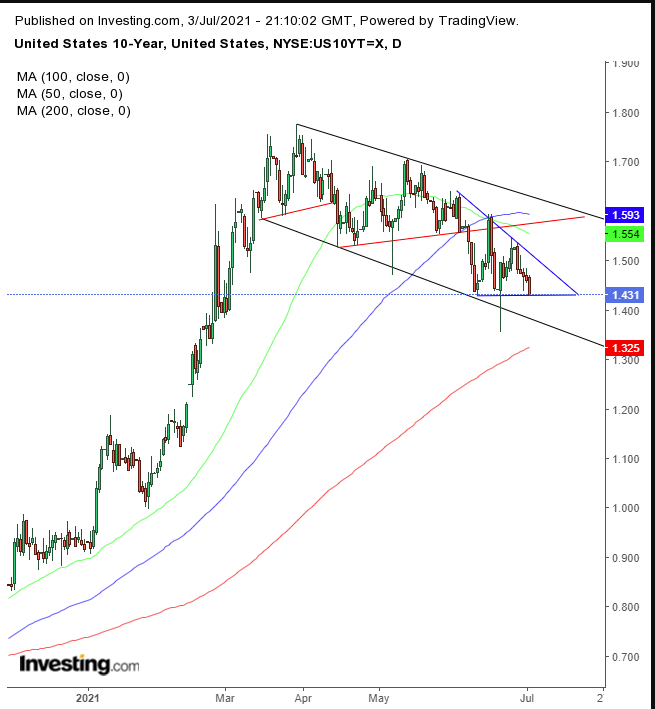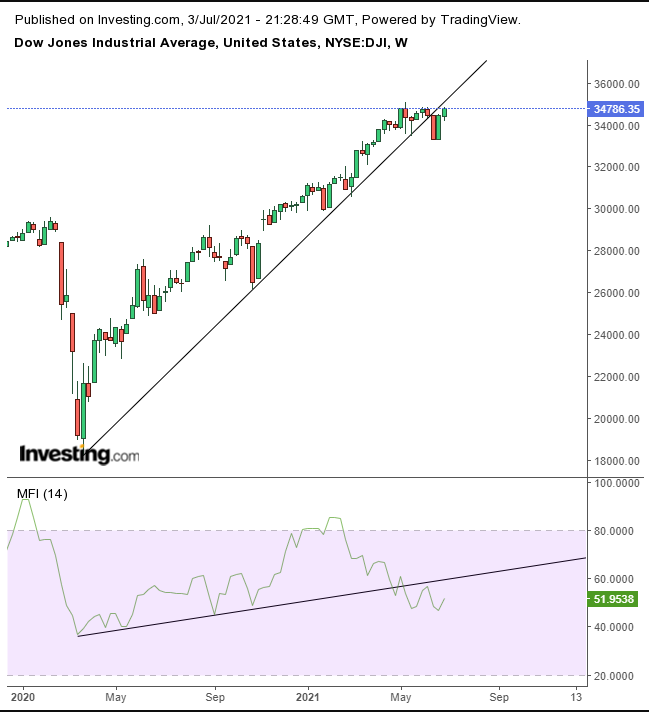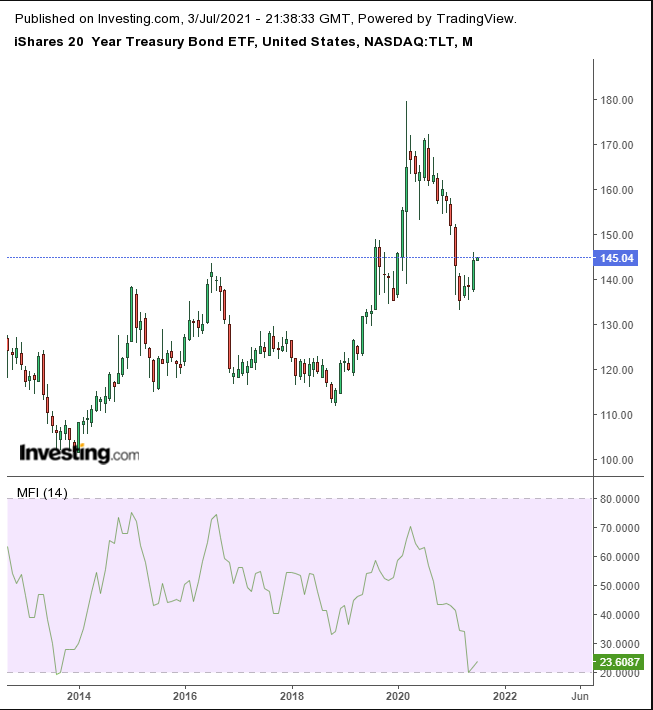- Stocks added to record highs on Friday after NFP—but why isn't clear
- Are investors still exuberant or just complacent?
Trading is expected to be light during the upcoming, holiday-shortened week, likely leaving stocks in a holding pattern beginning Tuesday, with four days of sparse economic data on the horizon. However, there's a potential market catalyst on Wednesday, with the release of the FOMC minutes from the June Fed meeting. These could provide additional clues regarding the US central bank's path to tightening.
Market Exuberance...But Why Exactly?
Three of the four major US benchmarks advanced on Friday. The Dow Jones, S&P 500 and NASDAQ Composite each extended a string of records after the release of the June nonfarm payrolls report which came in much hotter than expected. However, average hourly earnings and the unemployment rate disappointed expectations.
The question then is what was it about the data that excited investors enough to cause them to continue buying into the most expensive stocks in history? Was the catalyst the stronger-than-expected jobs growth, or were traders emboldened by the fact that salaries, and even participation, weren't, in fact, robust enough to raise inflation and thus justify the Fed’s plans to tighten.
The market narrative attributed Friday's moves to a “Goldilocks Economy,” considered the sweet spot for investors since, per the fairytale reference, it's neither too hot nor too cold. Rather, it's just right and therefore able to keep growing at a sustainable rate.
The S&P 500 closed at an all-time high for the seventh session in a row as the trading week ended, and ahead of the long holiday weekend to boot. Such a level of exuberance hasn't been seen since 1997.
If stocks are on the rise because the economy is chugging along, why then did the shares of economically sensitive corporations lag, while equities of companies that excel, specifically when the economy falters, provided superior returns?
The only two sectors in the red on Friday were cyclical stalwarts Energy (-0.2%) and Financials (-0.1%), while Technology stocks outperformed, (+1.3%).
The tech-heavy index was propelled higher by the five, now-over-a-trillion-dollar valuated tech companies: Apple (NASDAQ:AAPL), Microsoft (NASDAQ:MSFT), Amazon (NASDAQ:AMZN), Facebook (NASDAQ:FB) and Alphabet (NASDAQ:GOOGL).
On a weekly basis, while the SPX accelerated for the fifth week out of six, the NASDAQ 100 advanced for its seventh week in a row, the longest winning streak for this index since November 2019.
In contrast, the Russell 2000—whose small cap stocks represent the Reflation Trade—after having provided the worst results during social restrictions, has been moving sideways since March.
This pattern, the return of stocks that led during the pandemic, while value shares are once again being dumped, corresponds to the selloff in airlines and cruise companies as the delta variant escalates, with fresh outbreaks around the world.
There is an argument that it’s time for this bull market to pause, if not to outright correct, given that despite the impressive, recent string of records (perhaps too impressive) the broader participation of companies has been flat over the last three weeks.

The Advance/Decline Line, which plots the difference between the number of advancing and declining stocks, is less than half the height it was in January, where it found resistance at the August level, with the most S&P 500 stocks participating in the rally. In terms of the price action, the benchmark reached the top of a channel, increasing the probability of a bottom.
Another perspective that strengthens the bearish argument for equities: declining yields, including for the 10-year benchmark note, demonstrating investors have increased their Treasury holdings, something that happens when market participants want to preserve capital, at the expense of growth.

Yields have already completed two bearish patterns and are now testing the bottom of a descending triangle, which, if completed, will increase the probability of a sharper decline, framed within the current falling channel.
As well, the money flow for equities, as demonstrated by the MFI for the Dow Jones index, have been falling.

The Money Flow Index peaked out in February and has been sliding since, slipping below its uptrend line as early as April, providing a heads-up before the price did so in June.
This outflow is seen in the broader market too, via exchange traded funds, for example; $6 billion has left ETFs for US stocks in the week through Thursday. That’s quite a contrast from the incoming $200 billion in the first few months of the year.
Conversely, demand for safe havens triggered the second-highest monthly inflows to the iShares 20+ Year Treasury Bond ETF (NASDAQ:TLT), which has been climbing since March.

Note the monthly MFI is rebounding from its most oversold condition since August 2013. The ETF added 76% from that point until March 2021.
Even professional speculators have started reining in risk. During the final days of June, hedge funds reduced their long positions while covering their shorts. Combined, their risk-off activity reached the highest level since late January, via prime broker data compiled by the Goldman Sachs Group showed. Still, with net leverage sitting higher 90% of the time over the past year, positioning is hardly bearish.
What about us, are we turning bearish? Not yet. We can’t afford to go against the obvious uptrend. We’re just not putting all our eggs in one basket.
The Week Ahead
All times listed are EDT
Monday
Independence Day holiday in the United States, markets are closed
4:30: UK – Services PMI: expected to remain steady at 61.7.
Tuesday
00:30: Australia – RBA Interest Rate Decision: forecast to hold at 0.10%.
4:30: UK – Construction PMI: anticipated to edge lower to 63.5 from 64.2.
5:00: Germany – ZEW Economic Sentiment: likely to drop to 75.4 from 79.8.
10:00: US – ISM Non-Manufacturing PMI: seen to slip to 63.5 from 64.0.
Wednesday
10:00: US – JOLTs Job Openings: forecast to fall to 8.300M from 9.286M.
10:00: Canada – Ivey PMI: previous reading came in at 64.7 for May.
14:00: US – FOMC Meeting Minutes
Thursday
7:30: Eurozone – ECB Monetary Policy Statement
8:30: US – Initial Jobless Claims: predicted to slip to 355K from 364K.
11:00: US – Crude Oil Inventories: last week showed a drawdown of -6.71M Bbl.
Friday
2:00: UK – GDP: seen to drop to 1.7% from 2.3%.
2:00: UK – Manufacturing Production: to plunge to 29.5% from 39.7%.
6:00: UK – BoE Gov Bailey Speaks
6:00: Eurozone – ECB President Lagarde Speaks
8:30: Canada – Employment Change: forecast to surge to 175.0K from -68.0K.
Tentative: US – Fed Monetary Policy Report
